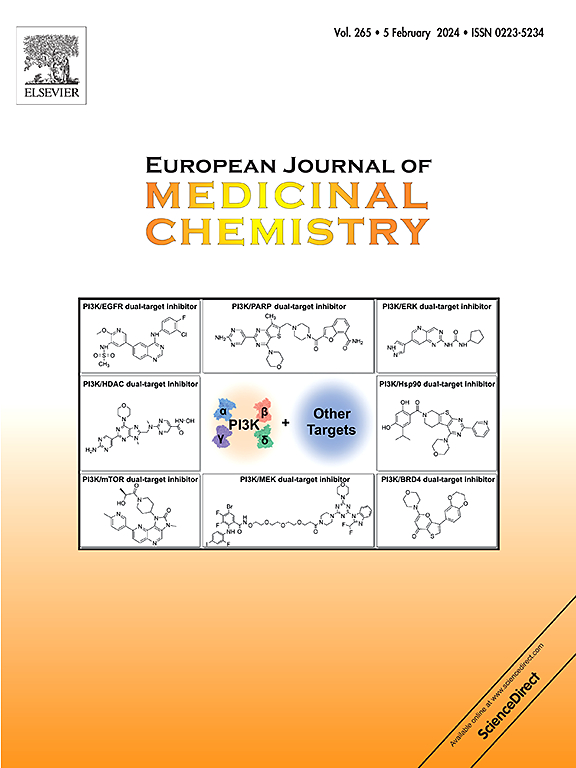Rational optimization of D3R/GSK-3β dual target-directed ligands as potential treatment for bipolar disorder: Design, synthesis, X-ray crystallography, molecular dynamics simulations, in vitro ADME, and in vivo pharmacokinetic studies
IF 6
2区 医学
Q1 CHEMISTRY, MEDICINAL
引用次数: 0
Abstract
Bipolar disorder is a complex neuropsychiatric condition with a significant unmet medical need, as current treatments lack disease-modifying properties and multimodal therapeutic effects. To overcome the limitations of single-target drugs, we designed dual-target ligands that combine partial agonism at the dopamine D3 receptor (D3R) with inhibition of glycogen synthase kinase-3β (GSK-3β). We previously identified ARN24161 (1) as a promising prototype, demonstrating partial agonism at D3R (EC50 = 10.1 nM, % Eff. = 26.3) and GSK-3β inhibition (IC50 = 561 nM). However, its drug-like properties remained suboptimal. To optimize this compound, we initiated a multidisciplinary refinement campaign, leveraging computational modeling and crystallographic data to fine-tune the balance between D3R and GSK-3β activity, reduce P-glycoprotein (P-gp) affinity, and improve the pharmacokinetic profile. This effort led to the identification of ARN25297 (5), a moderately balanced dual-target ligand that exhibits partial agonism at D3R (EC50 = 13.1 nM, % Eff. = 17.1) and potent GSK-3β inhibition (IC50 = 47.0 nM). Notably, ARN25657 (16) emerged as the most well-balanced candidate, demonstrating enhanced D3R partial agonism (EC50 = 15.2 nM, % Eff. = 37.7) alongside strong GSK-3β inhibition (IC50 = 19.3 nM). Compound 16 also exhibited the lowest P-gp inhibition and significant improvements in in vitro ADME properties compared to prototype 1, while maintaining a balanced dual target profile. Although the PK profile of 16 remained comparable to that of prototype 1, these findings lay the groundwork for further lead optimization and structural refinement, driving future in vivo proof-of-concept toward innovative therapeutic strategies for bipolar disorder and related neuropsychiatric conditions.


D3R/GSK-3β双靶向配体作为双相情感障碍潜在治疗的合理优化:设计、合成、x射线晶体学、分子动力学模拟、体外ADME和体内药代动力学研究
双相情感障碍是一种复杂的神经精神疾病,具有显著的未满足的医疗需求,因为目前的治疗方法缺乏疾病改善特性和多模式治疗效果。为了克服单靶点药物的局限性,我们设计了双靶点配体,结合了多巴胺D3受体(D3R)的部分激动作用和糖原合成酶激酶-3β (GSK-3β)的抑制作用。我们之前确定了ARN24161(1)作为一个有希望的原型,在D3R下显示出部分激动作用(EC50= 10.1 nM, % Eff)。= 26.3)和GSK-3β抑制(IC50= 561 nM)。然而,它的药物性质仍然不是最理想的。为了优化该化合物,我们启动了一项多学科的改进活动,利用计算建模和晶体学数据来微调D3R和GSK-3β活性之间的平衡,降低p糖蛋白(P-gp)亲和力,并改善药代动力学特征。这一努力导致鉴定了ARN25297(5),这是一种中等平衡的双靶配体,在D3R处表现出部分激动作用(EC50= 13.1 nM, % Eff)。= 17.1)和有效的GSK-3β抑制(IC50= 47.0 nM)。值得注意的是,ARN25657(16)成为最平衡的候选药物,显示出增强的D3R部分激动作用(EC50= 15.2 nM, % Eff)。= 37.7),并伴有强GSK-3β抑制(IC50= 19.3 nM)。与原型1相比,化合物16也表现出最低的P-gp抑制作用和体外ADME性能的显着改善,同时保持平衡的双靶点谱。虽然16的PK谱仍然与原型1相当,但这些发现为进一步的先导优化和结构改进奠定了基础,推动了未来双相情感障碍和相关神经精神疾病的创新治疗策略的体内概念验证。
本文章由计算机程序翻译,如有差异,请以英文原文为准。
求助全文
约1分钟内获得全文
求助全文
来源期刊
CiteScore
11.70
自引率
9.00%
发文量
863
审稿时长
29 days
期刊介绍:
The European Journal of Medicinal Chemistry is a global journal that publishes studies on all aspects of medicinal chemistry. It provides a medium for publication of original papers and also welcomes critical review papers.
A typical paper would report on the organic synthesis, characterization and pharmacological evaluation of compounds. Other topics of interest are drug design, QSAR, molecular modeling, drug-receptor interactions, molecular aspects of drug metabolism, prodrug synthesis and drug targeting. The journal expects manuscripts to present the rational for a study, provide insight into the design of compounds or understanding of mechanism, or clarify the targets.

 求助内容:
求助内容: 应助结果提醒方式:
应助结果提醒方式:


